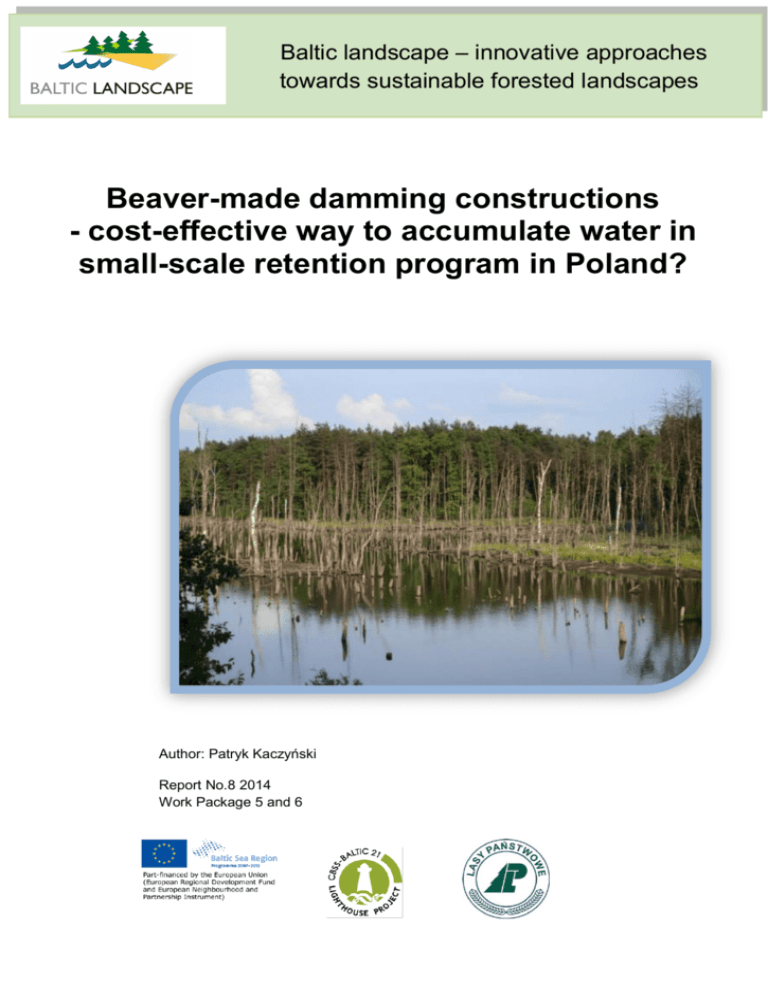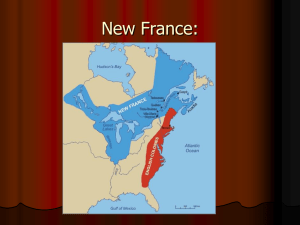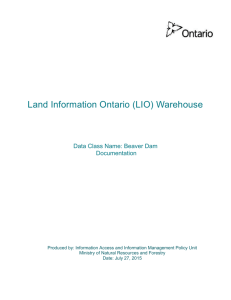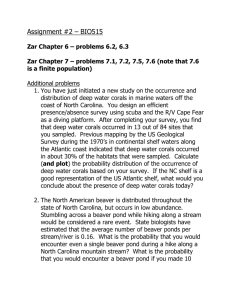Beaver-made damming constructions - cost
advertisement

Baltic landscape – innovative approaches towards sustainable forested landscapes Beaver-made damming constructions - cost-effective way to accumulate water in small-scale retention program in Poland? Author: Patryk Kaczyński Marja ReportKolström No.8 2014 Work Package 5 and 6 Date February 2014 Author: Patryk Kaczyński Partner organization: Regional Directorate of State Forests in Olsztyn Photographs: Patryk Kaczyński, Adam Gełdon Illustrations: Mateusz Grygoruk, Patryk Kaczyński Corresponding author: patryk.kaczynski@olsztyn.lasy.gov.pl http://www.baltic-landscape.net Content Abstract ........................................................................... 1 Small-scale water retention in the State Forests ............ 1 The purpose of small-scale retention ............................. 2 Planned effects of small-scale retention ........................ 2 Small-scale retention in the Regional Directorate of State Forests in Olsztyn 3 Include beaver pond and its retained water among small-scale retention structures ........................................................................................ 5 Create support fund for the residents of areas threatened by beaver-caused flooding ........................................................................................ 8 Preventative actions with active securing of lands as prevention against beaver damage. .......................................................................... 9 Some social aspects of the occurrence and activity of beavers in Poland 11 Final conclusions ........................................................... 11 LITERETURE ................................................................... 13 Abstract Due to the climate change and poor hydrological management, frequent floods and seasonal water deficiency has been observed in Poland in the past 50 years. To prevent its negative influence, State Forests of Poland participate in small-scale retention program, which aims to increase the retention capability of lowlands and prevent floods and droughts in forest ecosystems. Implementation of this activity by constructing hydrological objects has been found rather costly. European beaver population has been increasing in number in a past decades, causing damages to forest stands and farmlands. Beaver-made ponds which are a result of its natural activity, could function in similar way as small-scale retention objects. This study proposes a possible way of achieving goals of retention programme in Sate Forests, and tries to estimate to what extent beaver management can deliver a potential solution. This study also illustrates how funds saved as a result of adaptation of beaver ponds among small-scale retention structures could be directed to those affected by the negative aspects of beaver activities and prevent from local conflicts escalation. This study also shows the social and educational role of beaver ponds and also its influence on increasing biodiversity in surrounding areas. Paper concludes that beaver water retention role is highly underestimated and proper beaver management could be used as a tool of sustainable development. Small-scale water retention in the State Forests Observations from the last 50 years indicate an increase in the seasonal water deficiency in the Polish territory and increasingly frequent floods (1983, 2007, 2013). In many areas, due to global climate changes and mistaken irrigation activities, unfavourable trends in existing hydrologic conditions and natural environment were found. Lowering level of underground water, shrinking areas of water reservoirs, disappearance of mid-forest lakes, drying of the ground and natural humid settlements in the forests are only few of the examples. Another problem concerning water retention in Poland is the amount of available retained water per one inhabitant. In this aspect, Poland ranks fifth from the end in Europe with 1580m3/person/year with the European average at 4560m3/person/year (Tsznydel M., Tończyk G., 2012). Efforts have been made since the 1990s to prevent these problems by successfully realising the forest divisions of individual projects on small-scale retention. (CKPŚ 2009) As of 2009 a program titled: Increase of retention capability and prevention of flood and drought in forest ecosystems of the lowlands. 1 The purpose of small-scale retention The aim of this project is the retention of surface and underground waters in the areas under State Forest administration, within watersheds of watercourses, with simultaneous preservation and support of the development of a natural landscape (CKPŚ 2009). The basic plan of the project postulates the creation of 3300 small-scale retention structures. One of their objectives would be the retention of ca. 31 mlnm3 of water. A decision was made in the project to focus on small retention reservoirs with a capacity of up to 100 000 m3 of water and a damming of up to 5 m. One of the reasons for this move is a global tendency to break away from building large water reservoirs which quickly become shallow and are difficult and costly in maintenance. (Mioduszewski W., 2003.). The project assumed that high retention capabilities are created especially through the reconstruction of existing irrigation systems towards the inhibition of water drainage–a repair of old errors consisting in excessive water drainage. Actions resulting in a delay and limitation of drainage, e.g. damming up of water in ditches, ponds, waterholes and similar terrain depressions, from which water was drained through ditches. Depending on environmental conditions, various methods of water retention are applied: - increase of use of aquatic resources through adaptation of existing irrigation systems for retention functions and elimination of their negative influence on the ecosystem, including the damming up of water in a network of drainage ditches, and locally the elimination of redundant ditches, - construction of water reservoirs, - slowdown of water circulation in watersheds through rapids, artificial rapids, damming devices on watercourses, - renaturalisation of swamp areas, i.e. through inhibiting the drainage of surface waters. Planned effects of small-scale retention The planned investments, apart from increasing water resources and the level of underground waters, will be a significant element of protection of natural values of the forest ecosystem and increase its biodiversity. Indicators of successfully conducted activities may include: - a rise of the surface water level, - a rise of the underground water level, - a recreation or improvement of the condition of swamp areas, - a renewal of the peat formation process on the peat bogs, 2 - a positive influence on the species composition of neighbouring forest stands, improvement of their health and growth, - restoration of habitat sands the return of plants and animals associated with wetlandsthe maintenance and restoration of biodiversity in the local forest ecosystems. Also taken into account must be the fact that a successfully implemented small-scale retention program may result in local floodings of forest stands, meadows and pastures, making their proper management impossible. Due to the floodings, a local decay of forest stands and loss of crops may occur (CKPŚ 2009). If such effects do not exceed reasonable limits and are limited to the State Forest lands, they should be accepted. It is in fact an inevitable consequence of the fact that small-scale retention is to restore the natural hydrographic conditions in the scale of the landscape - sometimes it must therefore reverse the effects of earlier drainage made for the “regulation of hydrologic conditions”, afforestation or facilitation of management. Small-scale retention in the Regional Directorate of State Forests in Olsztyn The small-scale retention program in the Olsztyn RDSF involves 11 forest districts. They have committed themselves to build, recreate or restore to natural conditions 809 small-scale retention structures in their administrative area. These structures are to retain over 13 221 000 m3 of water. This equals ca. 16 300 m3 per object on average. In fact, the range of the retained water at the individual sites is large and ranges from 558 m3 to 300 000 m3 per object (CKPŚ 2009). Compared to the reservoirs created in the last century in the world, where the capacity of some exceeded 170 km3(!) and the surfaces reached several thousands of km2 (Lehner, B., 2005), those used throughout the RDSF in Olsztyn have a small capacity and small impact on a local nature. The created reservoirs may seem small, but the costs of small-scale retention are not counted among the lowest. The total cost of construction and adaptation of 809 structures has been planned for PLN 21 382 000. It is easy to calculate that the average cost per structure is about PLN 26 000. Considering the range of the amount of the collected water, this value is not accurate. More vivid probably will be the price of retention of one m3 of water. In the RDSF in Olsztyn this value is about 1.62 PLN/m 3. The approximate average cost of retention of 1 m3 of water in the scale of our country is about PLN 5. At the end of June 2013, 387 of the 809 planned structures (47%) were built in the RDSF in Olsztyn, and the amount of accumulated water is estimated to be 4 800 000 m3 (36%). The positive effects of water retention are undeniable, but from an economic point of view, the validity of such expenditures can be called into questioned. Nature on its own has already developed further more natural way of creating very similar constructions. Such facilities could easily be found on the areas inhabited by Castor fiber. The beaver is one of the few species, apart from humans, able to successfully and radically change the character of entire ecosystems to suit its needs. From an environmental perspective, 3 the presence of beavers in the area brings great benefits in the form of increased biological diversity of the flooded areas or in an improvement of hydrologic conditions. However, the matter could look a little different from the human perspective. The increasing population of this species is populating new areas which often border with lands used by humans. A conflict between the interests of land owners and beavers takes place in these areas most frequently (Tornblom J., Angelstam P., 2011). Though if we look at these problems from a broader perspective, it turns out that many of the actions undertaken by beavers are very concurrent with the objectives of forest management policy conducted in the State Forests. The construction process of human-made retention reservoirs, apart from its positive impact on the surrounding ecosystems, is unfortunately burdened with a number of disadvantages and difficulties resulting from their implementation. This process begins with the examination of the environmental conditions and planning of small-scale retention structures. This is done mainly through the determination of areas with water deficiency in the ecosystem and their causes. At this stage it is analyzed whether retention actions will not adversely affect surrounding areas protected by Nature2000. Their validity and cost effectiveness are examined in terms of achievable results. The second step is to obtain the necessary permits, including written agreements with the authorities responsible for wildlife protection of in the area, water managers in the region and the local government units depending on the location of the planned structure (CKPŚ 2009). The third step is to carry out selection procedures for contractors (EU tender) and the construction of the structure. Due to legal regulations and lengthy procedures, this stage prolongs the most the duration of the implementation of the Project. The fourth step is to commission the structure, monitor the technical condition of the structure and evaluate the efficacy of and compliance with the planned functions. This process is highly time-consuming and complex. A maze of regulations governing the obtaining of permits for construction of such a structure is often disproportionate to the amount of work put into its construction. In contrast, one can present here the process of building natural small-scale retention structures - beaver ponds. The beaver does not require a permit, does not care about administrative boundaries, or coordinate it with anyone regarding the position of their buildings. A medium-sized demolished dam can be rebuilt by beavers even over a few nights. The greatest of its assets is the fact that the beaver does not require direct funding. A proper beaver population management could be used as a tool to support reaching goals of a small-scale water retention program in Poland. Beaver not only could speed up the process significantly, but also affect social attitude to it. A mixture of beaver and human-made retention constructions would also find more acceptance in the society. This aim could be achieved in several ways. 4 Include beaver pond and its retained water among small-scale retention structures In their character and basic fulfilled functions, beaver ponds resemble small-scale retention structures. They are, however, not taken into account when calculating the amount of retained water in a given area. It is difficult to estimate whether the number of beaver ponds and their capacity is sufficient to be in the range of interest of hydrologists or the Forest Service. Some authors argue that the activity of beavers is comparable to all national small retention programs combined (Tsznydel M., Tończyk G., 2012). In order to estimate the amount of water stored in beaver ponds, estimates were limited to the boundaries of the Regional Directorate of State Forests in Olsztyn. Data on beaver population occurring here is selective and estimated therefore the need arose for the use of more reliable data. According to law, the Regional Directorate for Environmental Protection is a state administrative body which estimates the damage caused by beaver activity. The collected data includes: the number of damages, type of damage, quantification of damage (e.g. number of burrows, flooded area, etc.) and the amount of compensation paid. After the development of the data obtained from the RDOŚ it was found that in the region of Warmia and Mazury, which actually coincides with the area of RDSF in Olsztyn, 1038 cases of beaver damages were examined in the year 2012. The total of compensation paid is PLN 3 167 364 (at an average price of euro for the year 2012 being 4.19 = EUR 755 934,13). By comparison, in 2010 the number of damages was 726 at the value of PLN 1 626 497, and in 2011 the number of damages was 1053 with the value of compensations at PLN 2 783 925. There is a clear upward trend. According to data from 2012 the most common type of damage was flooded grassland. These floodings accounted for 63% of all cases of damage and the amount of compensation paid for them is PLN 1 943 836 (61%). The key value helpful in the calculation was surface damage which is the same as the area flooded by the building of dams by beavers in the surrounding water course. The total area of flooded grassland was 2254.18 with an average of 3.44 ha, and the extent of surface damage ranged from 0.18 to 45 ha. Research findings of M. Grygoruk from the Warsaw University of Life Sciences were used to estimate the capacity of each beaver pond formed by the flooding of grasslands. The research hypothesis of his study was the assumption that the amount of water stored in the pond is a result of the current hydrological situation of the watercourse, and the volume and surface of the beaver pond, which vary over time, can be presented as an ordinate of the elevation of the beaver dam and modeled with selected applications of the geographic information system (Grygoruk M ). Basing in his work on field measurements, the author created a digital model of the valley of the river Krzemianka where beavers had built a dam and a beaver pond appeared. Digital model of the pond shape and elevation helped to determine this pond capacity. Based on the obtained data set, the relationship between the surface of the water reservoir and its capacity was determined. 5 Fig. 1 Digital model of river Krzemianka (Grygoruk M., 2008) Since the area of the Krzemianka river valley has been extensively catalogued, and the model of the pond made using advanced computer programs - it served me as a model beaver pond. Using the above-mentioned relationship, I have determined a function of showing the change in the volume of the tank depending on its surface. Then, substituting the surface of individual wetlands (beaver damage from the area of the Warmia and Mazury voivodeship from 2012) to the formula I have determined the capacity of each flooded area as if it constituted a separate beaver pond. It has been discovered that the total capacity of wetlands determined in such a way amounts to 12 735 098 m3 of water. This value is very close to that planned to be achieved in the lowland small-scale retention project in the RDSF in Olsztyn. On this basis one can conclude that there is a basis for beaver ponds and water stored in them to become of interest to hydrologists and the Forest Service when planning small-scale retention structures. 6 Fig. 2. Graph of the relationship between the surface of the beaver pond and its capacity (Grygoruk M., 2008) The adopted method was to be used only to determine the order of magnitude of retained water in beaver ponds in the area of the RDSF in Olsztyn and is not without errors. It needs to be considered that only 60% of the beaver damage was taken into account when calculating the total capacity of wetlands. Beaver ponds that do not cause any damage to the area of RDSF have not been taken into account at all. On the other hand, not every flooding caused by beaver activity has the exact same structure as the model beaver pond regarded as a reference. If we assume that only half of beaver ponds would be suitable for adaptation as small-scale lowland retention structures, and water stored in them would be included in the retention balance sheet, we would achieve savings of several million zlotys. As a result of taking beaver ponds into consideration when calculating accumulated water we could easily achieve small-scale retention program aims with much lower costs than planned. Also the number of man-made constructions in the forests will decrease. 7 Create support fund for the residents of areas threatened by beaver-caused flooding Payment of compensation is at present the most common form of compensation in Poland for damage caused by the activities of the European beaver. Most European countries, including Germany and Sweden have long since moved away from such a system, introducing in its place preventive solutions, controlled culling or aid funds. The compensation system may also be an element of fraud, where the remaining of the status quo and exaggerating the conflict remains in the interest of the victim in order to receive further financial gain. The method of calculating compensation is not consistent in our country, and the difference in the calculation of compensations between the voivodeships appears to be significant. For example, in 2009 in the voivodeship of Podlasie examined over twice as many requests for compensation than in the voivodeship of Warmia and Mazury, and the amount of claims paid in the two regions were very similar (Janiszewski, P., 2012). Compensations are usually a heavy burden for the budgets of smaller voivodeships, thereby reducing the funds to carry out other activities in the field of environmental protection and sometimes causing reluctance of the environmental services themselves. In opinion of many of the victims, the compensation sums paid do not fully compensate for the losses, especially for the fishermen (Klosowski J., 2010). Sometimes it is inducing people to poaching or illegal habitat destruction. The money saved as a result of adaptation of beaver ponds as small-scale retention structures could be used to replenish the aid fund, which would be directed to those affected by the negative activities of beavers. Such fund would be a great tool to help to manage beaver population. Mainly, it would compensate landowners for excluding from production the areas flooded by beavers and keep them in an unaltered state. The scientists’ research shows that 90% of the damage caused by beavers is formed in the immediate vicinity (up to 10m) of a watercourse (Czech, A., 2007). Creating there ecotone zones and their exemption from use could prevent most conflicts. After the beaver population becoming stable in a given area only 3% of the sites would continue to cause damage (Czech, A., 2010), (Tsznydel M., Tończyk G., 2012). In areas where beavers have been dwelling for a long time, there is little land available for population and intensive formation of family colonies, so migrations occur over short distances and new sites are created in the immediate vicinity of the former ones. Thus, new pools are not created, but supplied by those already existing in a given area (Janiszewski, P., 2012). Removing from or shooting beavers in places of conflict usually brings short-term effects, as roving specimens finding abandoned and convenient places to live will quickly settle in them (usually within the following year). The results are new damages in the same places. (Czech, A., 2010). In some cases voivodeship could propose buy off flooded lands (using savings from not having to pay compensation) or their conversion or redemption for the ones in a larger distance from the beaver habitats. 8 An interesting phenomenon that could encourage the beavers to cut down more trees in the area is the dismantling of beaver dams as a precautionary measure against losses due to flooding. The beaver will instinctively try to repair or rebuild the dam, cutting down more trees in order to obtain building material. Having suitable access to materials, beavers can rebuild a medium-sized dam within a few nights. (Janiszewski, P., 2012). These studies brings us to a conclusion, that in longer time perspective creating ecotone zones alongside the water streams near grassland or farmlands will bring more benefits to both beaver population and land owners. These solutions will help to mitigate conflicts between beaver activities and local society. Preventative actions with active securing of lands as prevention against beaver damage The ideal solution of most of the problems with beavers would be the introduction of the principle of leaving a natural buffer zone of about 20 - 50 meters by watercourses and reservoirs, in which there would be no intensive agricultural usage (Czech A., 2010). This can be done in many ways, such as through the exclusion of land from use, creation of ecological lands, nature reserves and other forms of protection. Some consequences of beaver activities can be easily predicted. Newly built roads, dams and buildings located in river valleys or on their outskirts should be placed on higher grounds that will not be flooded even if beavers raise the water level. They should be located on embankments or natural elevations in the area. This solution is very effective and long-lasting (Czech A., 2010). New investments and structures should be designed and implemented in such a way as to prevent the possibility of their destruction by beavers. It is very important because usually costs of prevention are lower than costs of possible future repair. You can also actively prevent against colonization new areas by beavers. Preventing colonization should be used only where engineering beaver activity can endanger human life or cause major economic damage. Prevention against colonization usually boils down to a lessening of attractiveness of an environment in which the beavers could settle and cause potential damage (Czech A., 2010). It is possible to change the species composition of tree plantings growing on the edges of ditches or ponds –instead of species favoured by beavers, plant trees and shrubs unattractive to them, such as conifer, alder, etc. Securing the culverts potentially exposed to flooding and destruction by beavers is another example of preventive actions. Properly used procedures and devices often enable complete and permanent avoidance of significant damage arising from beaver activities. In many cases, it turns out that they are much more effective and cheaper than attempts to destroy their dams and other constructions. 9 Fig. 3. Flow pipe inserted into the beaver dam in Spychowo forest district (Spychowo small-scale retention program documentation.) In some cases protecting valuable trees with metal nettings is considered a very efficient way to prevent beaver from settling in the area (Czech A., 2010). Without building supplies surroundings would be far less attractive for the beavers. In case beavers have already build up a dam, it was proved that inserting flow pipes in it, is much more effective way of decreasing water level in the nearby area than dismantling the dam, which in some cases could be rebuilt overnight (Czech A., 2010). Educational activities and conflict advisors The victims` attitude to beaver damage often depends on personal point of view and knowledge about the beavers. Education of victims often results in the withdrawal of claims. A rapid response and an expression of real interest in the particular issue have an essential meaning. Educational activities have a long-term impact on the management of the beaver population, and they can yield better results than compensation itself. 10 Money from the fund could also be used for the training of those responsible for the initial contact with victims of beaver damages or other people interested in beavers and their activities. Such a person should be trained in the biology and ecology of beavers and their impact on environment, conducting field work, and should have negotiation and sociological skills needed to work with the society. They would be responsible for conducting basic monitoring of the beaver population and its impact on the local environment, they would be the first person to resolve or examine conflicts and establishing contact with a victim. This knowledge and the recognition of indigenous peoples’ rights and the diversification of values related to forests have led to demands for broader involvement of the affected people in the decision-making regarding in cases such as beaver management (Raitio K., 2008). Some social aspects of the occurrence and activity of beavers in Poland Beavers have been accused of allegedly being one of the causes of the disastrous effects of the great flood that took place in 2007. Those suggestions do not have a lot in common with the reality. They were used to cover up years of neglecting committed by the Polish state in water management and flood prevention. Such presentation of the matter in the media caused a polarization of views and opinions on the beaver in society, in contrast to treating this animal as exotic at a time when it was in danger of extinction. (Dyer R. A., Butler E. B., 2007). On the contrary beavers can enhance the natural values of many places such as educational trails or footpaths, which can be successfully established in the vicinity of beaver locations and are a great place where many occurring natural phenomena can be described within a small area. They are increasing the attractiveness of habitats and landscape elements in terms of tourism, where people could feel closeness to the wild nature. Promotional campaign which would explain how well beavers contribute to the amount of water stored in forest could not only improve the society attitude to the specie but also promote pro ecological multifunctional Forest Service forest management. It has been found that in the conflict areas beavers sometimes tend to cause reluctance of local society, but that usually depends very much on the personal attitude to the beaver itself and knowledge about it (Czech A., 2010). Final conclusions Beaver management in Poland has been developing over the last century in different aspects. Numerous times it was found that its proper handling can influence many local areas of interest such as agriculture or forestry. Small-scale retention program is very important and valuable issue from the State Forests` of Poland point of view nowadays. Apart from its positive biological aspects it could be considered as rather costly. Proper beaver management including participation and cooperation of regional authorities with 11 local society was found to be a very useful tool to mitigate conflicts and combine interests of all involved parties. Innovative approach to the beaver-made constructions has showed to be the possible, low-cost solution of increasing forest water capacity. Beavers also have a significant impact on increasing the biodiversity of plants and animals appearing in the modified ecosystems as well as increasing the density of biomass of fauna and flora around them. Change in the beaver management is a good example where the humanity and its relationship with the biosphere, has to be changed in fundamental ways if this biosphere is going to be able to sustain human society in the long-term. What is foreseen, as argued here, is not some modifications within the current system, but rather a new economic and ethical system in order to arrive at ‘sustainable development’(Holmgren L. 2008). 12 Literature Centrum Koordynacji Projektów Środowiskowych, CKPŚ 2007. Koncepcja programowoprzestrzenna dla projektu: Zwiększanie możliwości retencyjnych oraz przeciwdziałanie powodzi i suszy w ekosystemach leśnych na terenach nizinnych. Centrum Koordynacji Projektów Środowiskowych, CKPŚ 2009. Podręcznik wdrażania projektu – Wytyczne do realizacji obiektów małej retencji w Nadleśnictwach Zwiększanie możliwości retencyjnych oraz przeciwdziałanie powodzi i suszy w ekosystemach leśnych na terenach nizinnych. Czech A., 2005. Analiza dotychczasowych rodzajów i rozmiaru szkód wyrządzanych przez bobry (Castorfiber) oraz stosowanie metod rozwiązywania sytuacji konfliktowych Czech A., 2010. Bóbr - budowniczy i inżynier. Czech A., 2007. Krajowy plan ochrony gatunku Bóbr europejski Castorfiber. Dyer R. A., Butler E. B., 2007. Management of Beaver Damage within the State of Maine. United States Department of Agriculture Animal and Plant Health Inspection Service Wildlife Services Grygoruk M., Metodyka szacowania objętości retencyjnej stawów bobrowych oraz ich oddziaływania na stosunki wodne zlewni leśnych. Studia i Materiały Centrum Edukacji Przyrodniczo-Leśnej R. 10. Zeszyt 2 (18) / 2008, str. 162-172 Holmgren L. 2008. Framing Global Public Policy on Forests Janiszewski P., Misiukiewicz W., 2012. Bóbr eurpoejskiCastorFiber. Klosowski J., 2010. Human–wildlife conflicts at pond fisheries in eastern Poland: perceptions and management of wildlife damage. Eur J Wildl Res (2011) 57: 300 Lehner B., Czisch G.,Vassolo S., 2005. The impact of global change on the hydropower potential of Europe: a model-based analysis. Mioduszewski W., 2003. Mała retencja. Ochrona zasobów wodnych i środowiska naturalnego. Poradnik. Morris G., Fan J., 1998. Reservoir sedimentation handbook: design and management of dams, reservoirs and watershed of sustainable use. Raitio K., 2008. You can`t please everyone. Conflict management practices frames and institutions in Finnish State Forests. Tornblom J., Angelstam P., 2011. Toward a Research Agenda for Water Policy Implementation: Knowledge about Beaver (Castofr fiber) as a Tool for Water Management with a Cathment Perspective Tsznydel M., Tończyk G., 2012.Bóbr - przyjaciel czy wróg? Naturalna Mała retencja odpowiedzią na niewykorzystany bilans wodny P 14 13






